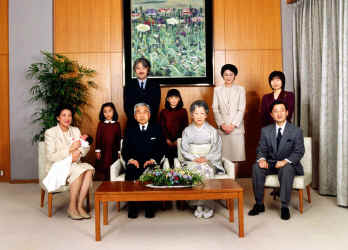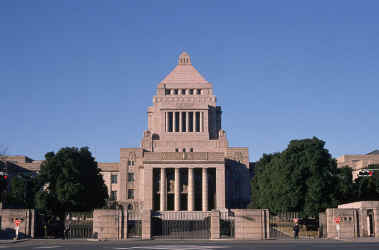|
|
|
|
|
|
|
Back to Japan
Politics
in Japan
|
|
|
|

|
|
|
AsianInfo.org
supports I.C.E.Y. -
H.O.P.E. (non-profit org)
(International
Cooperation of Environmental Youth - Helping Our Polluted
Earth) Any advertisement you view helps save the
environment! Thanks! |
|
In
1890 the Imperial Diet was established, making Japan
the first country in Asia to introduce parliamentary
politics. The Diet is the sole legislative
organ of the state and the highest organ of power.
It is vested with such powers as initiating
constitutional revisions, deciding on the budget,
approving treaties and designating a prime minister.
The
upper house, or the House of Peers, of the Imperial
Diet was made up of representatives of the
privileged class, especially the peerage and the
Japan remained an absolute monarch, with sovereignty
in the hands of the emperor. It was only in
November 1946, when the present Constitution was
promulgated, that sovereignty was given to the
people and a democratic system government was
adopted. Now the emperor is the symbol of the
state and the Diet is the supreme organ of state
power.
The
present system is built on the separation of powers
of the three branches of government - legislative,
executive and judicial - which act to check and
balance one another. Administration at the
prefectural level is centered on the governor and
assembly of each of the 47 prefectures.
The governor and assembly members are elected
directly by residents of the prefecture. Under
each prefectural government is a system of city,
town, and village administrations. These
municipal assemblies and mayors are also elected
directly by local residents.
More...
Back to Top
|
|

|
|
Country name:
|
|
conventional long form: none
conventional short form: Japan
local long form: Nihon-koku/Nippon-koku
local short form: Nihon/Nippon
|
|
|
Government type:
|
|
a parliamentary government with
a constitutional monarchy
|
|
|
Capital:
|
|
name: Tokyo
geographic coordinates: 35
41 N, 139 45 E
time difference: UTC+9
(14 hours ahead of Washington, DC during Standard
Time)
|
|
|
Administrative divisions:
|
|
47 prefectures; Aichi, Akita,
Aomori, Chiba, Ehime, Fukui, Fukuoka, Fukushima,
Gifu, Gunma, Hiroshima, Hokkaido, Hyogo, Ibaraki,
Ishikawa, Iwate, Kagawa, Kagoshima, Kanagawa,
Kochi, Kumamoto, Kyoto, Mie, Miyagi, Miyazaki,
Nagano, Nagasaki, Nara, Niigata, Oita, Okayama,
Okinawa, Osaka, Saga, Saitama, Shiga, Shimane,
Shizuoka, Tochigi, Tokushima, Tokyo, Tottori,
Toyama, Wakayama, Yamagata, Yamaguchi, Yamanashi
|
|
|
Independence:
|
|
3 May 1947 (current
constitution adopted as amendment to Meiji
Constitution); notable earlier dates: 660 B.C.
(traditional date of the founding of the nation by
Emperor JIMMU); 29 November 1890 (Meiji
Constitution provides for constitutional monarchy)
|
|
|
National holiday:
|
|
Birthday of Emperor AKIHITO, 23
December (1933)
|
|
|
Constitution:
|
|
3 May 1947
|
|
|
Legal system:
|
|
modeled after European civil
law systems with English-American influence;
judicial review of legislative acts in the Supreme
Court; accepts compulsory ICJ jurisdiction with
reservations
|
|
|
Suffrage:
|
|
20 years of age; universal
|
|
|
Executive branch:
|
|
chief of state: Emperor
AKIHITO (since 7 January 1989)
head of government: Prime
Minister Naoto KAN (since 8 June 2010)
cabinet: Cabinet
is appointed by the prime minister
elections: Diet
designates the prime minister; constitution
requires that the prime minister commands
parliamentary majority; following legislative
elections, the leader of majority party or leader
of majority coalition in House of Representatives
usually becomes prime minister; the monarchy is
hereditary
|
|
|
Legislative branch:
|
|
bicameral Diet or Kokkai
consists of the House of Councillors or Sangi-in
(242 seats - members elected for fixed six-year
terms; half reelected every three years; 146
members in multi-seat constituencies and 96 by
proportional representation) and the House of
Representatives or Shugi-in (480 seats - members
elected for maximum four-year terms; 300 in
single-seat constituencies; 180 members by
proportional representation in 11 regional blocs);
the prime minister has the right to dissolve the
House of Representatives at any time with the
concurrence of the cabinet
elections: House
of Councillors - last held on 11 July 2010 (next
to be held in July 2013); House of Representatives
- last held on 30 August 2009 (next to be held by
August 2013)
election results: House
of Councillors - percent of vote by party - DPJ
31.6%, LDP 24.1%, YP 13.6%, NK 13.1%, JCP 6.1%,
SDP 3.8%, others 7.7%; seats by party - DPJ 106,
LDP 84, NK 19, YP 11, JCP 6, SDP 4, others 12
House of Representatives -
percent of vote by party (by proportional
representation) - DPJ 42.4%, LDP 26.7%, NK 11.5%,
JCP 7.0%, SDP 4.3%, others 8.1%; seats by party -
DPJ 308, LDP 119, NK 21, JCP 9, SDP 7, others 16
(2009)
|
|
|
Judicial branch:
|
|
Supreme Court (chief justice is
appointed by the monarch after designation by the
cabinet; all other justices are appointed by the
cabinet)
|
|
|
Political parties and
leaders:
|
|
Democratic Party of Japan or
DPJ [Naoto KAN]; Japan Communist Party or JCP
[Kazuo SHII]; Liberal Democratic Party or LDP [Sadakazu
TANIGAKI]; New Komeito or NK [Natsuo YAMAGUCHI];
People's New Party or PNP [Shizuka KAMEI]; Social
Democratic Party or SDP [Mizuho FUKUSHIMA]; Your
Party or YP [Yoshimi WATANABE]
|
|
|
Political pressure groups
and leaders:
|
|
other: business
groups; trade unions
|
|
|
International organization
participation:
|
|
ADB, AfDB (nonregional member),
APEC, ARF, ASEAN (dialogue partner), Australia
Group, BIS, CE (observer), CERN (observer), CICA
(observer), CP, EAS, EBRD, FAO, FATF, G-20, G-5,
G-7, G-8, G-10, IADB, IAEA, IBRD, ICAO, ICC, ICCt,
ICRM, IDA, IEA, IFAD, IFC, IFRCS, IHO, ILO, IMF,
IMO, IMSO, Interpol, IOC, IOM, IPU, ISO, ITSO, ITU,
ITUC, LAIA (observer), MIGA, NEA, NSG, OAS
(observer), OECD, OPCW, OSCE (partner), Paris
Club, PCA, PIF (partner), SAARC (observer), SECI
(observer), UN, UN Security Council (temporary),
UNCTAD, UNDOF, UNESCO, UNHCR, UNIDO, UNMIS, UNRWA,
UNWTO, UPU, WCO, WFTU, WHO, WIPO, WMO, WTO, ZC
|
|
|
Diplomatic representation in
the US:
|
|
chief of mission: Ambassador
Ichiro FUJISAKI
chancery: 2520
Massachusetts Avenue NW, Washington, DC 20008
telephone: [1]
(202) 238-6700
FAX: [1]
(202) 328-2187
consulate(s) general: Atlanta,
Boston, Chicago, Denver, Detroit, Agana (Guam),
Honolulu, Houston, Los Angeles, Miami, New York,
Portland (Oregon), San Francisco, Seattle
consulate(s): Anchorage,
Nashville
|
|
|
Diplomatic representation
from the US:
|
|
chief of mission: Ambassador
John V. ROOS
embassy: 1-10-5
Akasaka, Minato-ku, Tokyo 107-8420
mailing address: Unit
9800, Box 300, APO AP 96303-0300
telephone: [81]
(03) 3224-5000
FAX: [81]
(03) 3505-1862
consulate(s) general: Naha
(Okinawa), Osaka-Kobe, Sapporo
consulate(s): Fukuoka,
Nagoya
|
|
|
Flag description:
|
|
white with a large red disk
(representing the sun without rays) in the center
|
|
|
National anthem:
|
|
name: "Kimigayo"
(The Emperor"s Reign)
lyrics/music: unknown/Hiromori
HAYASHI
note: adopted
1999; in use as unofficial national anthem since
1883; oldest anthem lyrics in the world, dating to
the 10th century or earlier; there is some
opposition to the anthem because of its
association with militarism and worship of the
emperor
|
|
|
|
|
|
|
|






